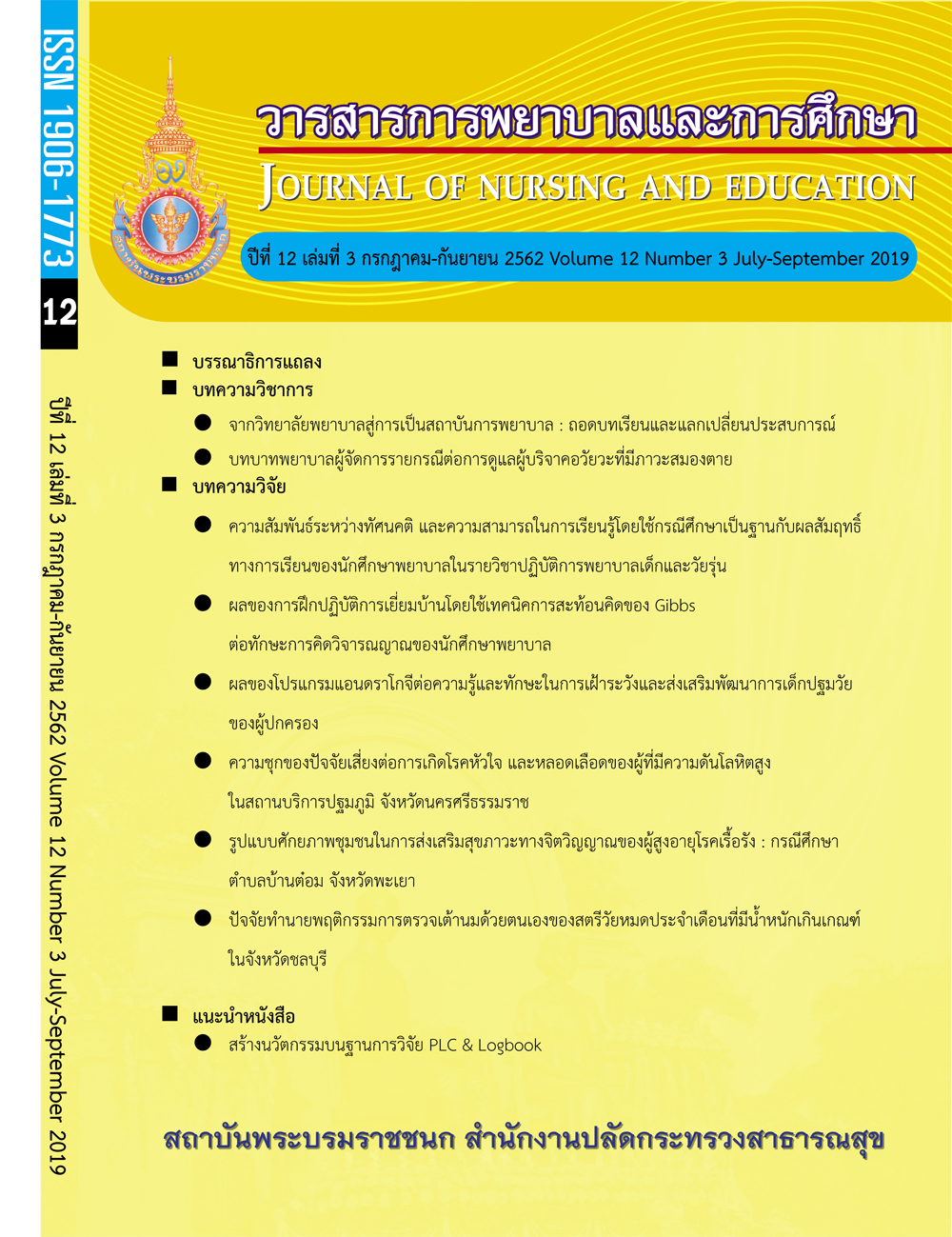รูปแบบศักยภาพชุมชนในการส่งเสริมสุขภาวะทางจิตวิญญาณของผู้สูงอายุโรคเรื้อรัง: กรณีศึกษา ต. บ้านต๋อม จ. พะเยา
Community Capacity Model for Promoting Spiritual Well-Being among Thai Older People with Chronic Illness: A case study of Tambon Ban Tom, Phayao Province
คำสำคัญ:
รูปแบบศักยภาพชุมชน, สุขภาวะทางจิตวิญญาณ, ผู้สูงอายุ, โรคเรื้อรังบทคัดย่อ
บทคัดย่อ
การวิจัยแบบผสมผสานครั้งนี้มีวัตถุประสงค์เพื่อศึกษาระดับสุขภาวะทางจิตวิญญาณ ศักยภาพชุมชน และรูปแบบของศักยภาพชุมชนในการส่งเสริมสุขภาวะทางจิตวิญญาณของผู้สูงอายุโรคเรื้อรังในชุมชน ตำบลบ้านต๋อม จ. พะเยา กลุ่มตัวอย่างในวิธีวิจัยเชิงปริมาณคือ ผู้สูงอายุที่เจ็บป่วยด้วยโรคเรื้อรัง จำนวน 320 คน โดยใช้วิธีสุ่มกลุ่มตัวอย่างแบบหลายขั้นตอน และกลุ่มตัวอย่างในวิธีวิจัยเชิงคุณภาพคือ ผู้สูงอายุที่เจ็บป่วยด้วยโรคเรื้อรังและบุคคลที่เกี่ยวข้องกับการดูแลผู้สูงอายุโรคเรื้อรัง จำนวน 50 คน โดยเลือกกลุ่มตัวอย่างแบบเจาะจง เครื่องมือวิจัยประกอบด้วย 1) แบบวัดความผาสุกทางจิตวิญญาณสำหรับผู้ใหญ่ชาวไทยพุทธที่เจ็บป่วยเรื้อรัง มีค่าความเชื่อมั่น .81 และ 2) แบบสัมภาษณ์กึ่งโครงสร้างศักยภาพชุมชนในการส่งเสริมสุขภาวะทางจิตวิญญาณ เก็บข้อมูล 2 ระยะ ระยะที่ 1 การประเมินสุขภาวะทางจิตวิญญาณ ระยะที่ 2 เป็นการศึกษาเชิงคุณภาพประเมินศักยภาพชุมชนในการส่งเสริมสุขภาวะทางจิตวิญญาณ โดยวิธีการสนทนากลุ่มและการสัมภาษณ์เชิงลึก เพื่อพัฒนารูปแบบ วิเคราะห์ข้อมูลโดยใช้สถิติพรรณนาและการวิเคราะห์เนื้อหา ผลการศึกษาพบว่า ระดับสุขภาวะทางจิตวิญญาณโดยรวมและรายด้านอยู่ในระดับสูง ( Mean = 3.76, S.D. = .87) ศักยภาพชุมชนมี 5 องค์ประกอบ ได้แก่ การมีส่วนร่วมของชุมชน ภาวะผู้นำ จิตสำนึกของชุมชน เครือข่ายในชุมชน และทรัพยากรในชุมชน ศักยภาพชุมชนในการส่งเสริมสุขภาวะทางจิตวิญญาณ เริ่มต้นจากการประเมินปัญหา วางแผนดำเนินการ และประเมินผล โดยประยุกต์องค์ความรู้และประสบการณ์ที่มีไปใช้ให้เหมาะสมกับสภาพบริบทพื้นที่ รวมทั้งการพัฒนาเครือข่ายและความร่วมมือทั้งภายในและภายนอกชุมชนอย่างต่อเนื่อง เกิดเป็นปัจจัยสำคัญที่ส่งผลให้การดำเนินกิจกรรมประสบความสำเร็จ
เอกสารอ้างอิง
1. Puchalski C, O’Donnel, E. Religious and spiritual beliefs in end of life care: How major religions view death and dying. Techniques in Regional Anesthesia and Pain Management 2005; 9(3): 114-121.
2. Robb C, Haley WE., Balducci L, Extermann M, Perkins EA, Small BJ, Mortimer J. Impact of breast cancer survivorship on quality of life in older women. Critical Reviews in Oncology/Hematology , 2007; 62: 84-91.
3. Tongprateep T. Spiritual care: Nursing process. The Thai Journal of Nursing Councilj, 2002; 17(1): 1-12. (in Thai).
4. Kissane DW, Clarke DM, Street AF. Demoralization syndrome: a relevant psychiatric diagnosis for palliative care. Journal of Palliative Care [Online]. 2001 [cited 2014 August, 9]; 17(1):12-21. Available from: http://europepmc.org/abstract/MED/11324179.
5. Morita T, Kawa M, Honke Y, Kohara H, Maeyama E, Kizawa Y, Uchitomi Y. Existential concerns of terminally ill cancer patients receiving specialized palliative care in Japan. Support Care Cancer, 2003; 12(2): 137-40.
6. Hall, BA. Spirituality in terminal illness. Journal of Holistic Nursing [Online]. 1997 [cited 2016 July 10]; 15(1): 82-96. Available from http://www.ncbi.nlm.nih.gov/pubmed/9146197.
7. Norton, BL, Mcleroy, KR, Burdine, JN, Felix, MR, Dorsey, AM. Community capacity: concept, theory, and methods. pp 194-227. In: Diclemente, RA, Crosby RA, Kegler MC. Emerging theories in health promotion practice and research: strategies for improving public health.2002; CA: Jossey-Bass, San Francisco.
8. Phayao Provincial Public Health Office. The reported number of aging. [database on the Internet]. [cited 2016 Aug 3]. Available from: http://61.7.231.104/chronic/rep_serv_newpt.php (in Thai).
9. Goodman, RM, Speers, MA, Mcleroy, K, Fawcett, S, Kegler, M, Parker, E, Smith, SR, Sterling, TD, Wallerstein, N. Identifying and defining the dimensions of community capacity to provide a basis for measurement. Health Education & Behavior, 1998; 25(3): 258-278.
10. Promkaewngam S, Pothiban L, Srisuphan W, Sucamvang K. Development of the Spiritual well-being Scale for Thai Buddhist Adults with Chronic Illness. Pacific Rim International Journal of Nursing Research 2013; 18(4): 320-32.
11. Burns N, Grove SK. The practice of nursing research: Conduct, critique, and utilization (5th ed.).2005. St. Louis, MO: Elsevier. 864 p.
12. Patton MQ. Qualitative evaluation and research methods.1990.CA: Sage, Newbury Park. 532 p.
13. Promkaewngam S, Namwong A. The Spiritual Well-Being of Community-Dwelling Thai Oder People with Chronic Illness. Nursing and Health Care 2017; 35(3): 204-213. (in Thai)
14. Hood Morris LE. A spiritual well-being model: Use with older women who experience depression. Issues in Mental Health Nursing 1996; 17(1): 439-55.
15. Gove WR, Ortega ST, Style CB. The maturational and role perspectives on aging and self through the adult years: An empirical evaluation. American Journal of Sociology 1989; (94): 1117-1145.
16. Mongkhonittivech N, Yeammisri W. Factors predicting spiritual well-being among the elderly with chronic illness Journal of Nursing Science & Health 2016; 39(2): 1-11. (in Thai).
17. Carson BV, Green H. Spiritual well-being: A predictor of hardiness in patient with AIDS. Journal of Professional Nursing [Online].1992 [cited 2016 July 16]; 8(4): 209-220. Available from http://www.sciencedirect.com/science/article/pii/875572239290082A.
18. Wongsrikaew K, Ruanggoon J, Chunprasert S. Development of Strong Community: A Case Study of Poonbumphen Community, Phasi Charoen District, Bangkok. Journal of Community Development and Life Quality. 2017; 5(1): 46-57. (in Thai).
19. Hill, K. and N. Harris. Royal flying doctor service ‘field days’: A move towards more comprehensive primary health care. Australian Journal of Rural Health 2008; 16(5): 308-312.






